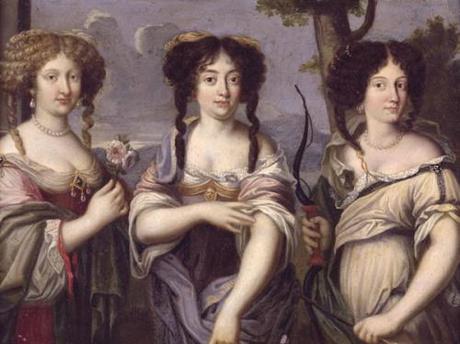
Portrait of three of the nieces of Cardinal Mazarin portrayed as goddesses, Venus, Juno and Diana, unknown artist. Photo: Musee de la Ville de Paris, Musee du Petit-Palais, France.
One of my favorite characters while writing my seventeenth century novel Minette was the amazing Marie Mancini – she just seemed to light up every single scene that she deigned to appear in and made a perfect foil for my rather naive heroine. In fact, I was so enamoured with Marie and indeed her entire bevy of ridiculously drama queeny sisters that I may just have to give them their own book one day. One day.
Marie Mancini was born in Rome on the 28th of August 1639, the third daughter of Lorenzo Mancini, a Roman aristocrat with a rather unusual passion for astrology and necromancy, and his wife, Hieronyma Mazzarini, who was the sister of Cardinal Mazarin, who was more or less running the show in France at the time. As might be expected of someone who was really into astrology, Marie’s father read the planets shortly after her birth and predicted that she would bring trouble to the family name in the future, a gloomy prediction that caused Hieronyma to rather set her heart on Marie entering a convent.
There would eventually be five Mancini girls in the family – Laure, Olympe, Marie, Hortense and Marie Anne. All of them with their own distinct personalities and all of them Italian firecrackers with bold, dark good looks, flashing sloe like eyes and a sharp keen intelligence and often rather caustic wit that the traditional convent education endured by girls of the Roman aristocracy did nothing to dampen. They were also all tremendous readers, with Marie particularly enjoying romances and her father’s rather more esoteric books, which filled the Mancini palazzo. It’s no surprise therefore that their uncle, Cardinal Mazarin, was soon agitating for the girls to be brought to Paris to set the French court about the ears and make far more glittering and prestigious marriages under his aegis than they might otherwise have done in Italy.
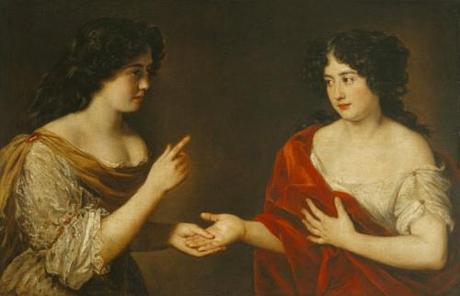
Marie and Hortense Mancini, Vouet, 1670. Photo: The Royal Collection/Her Majesty Queen Elizabeth II 2014.
Therefore in the 1650s, after the death of their potentially embarrassing father had left Hieronyma a widow, the Mancini girls made their way, in batches, to Paris. First to go was Laure, who was promptly married off to the Duc de Vendôme in February 1651; with Olympe coming out next in 1652, followed by Hortense and Marie in the spring of 1653 (arriving in 1654) and then finally Marie Anne, who was just six when she arrived in Paris in 1655.
Before making the journey to Paris, Hieronyma made one last ditch attempt to persuade thirteen year old Marie to enter a convent and take the veil on a permanent basis but her daughter refused, saying: ‘There are convents everywhere, and if it should please Heaven to inspire such pious impulses in me, it would be as easy to follow them in Paris as in Rome.’ It was clear however that she had no intention of such ‘pious impulses’ ever arising and it was great excitement, realising that this was the beginning of an amazing new life, that Marie enjoyed the journey from Italy to France, staying on the way with her eldest sister, Laure, whose own magnificent marriage to a duke no less must surely have inspired equal ambitions in the hearts of her younger sisters.
In Paris, the Mancini sisters lived along with their cousins, the Martinozzi girls, Laure and Anne Marie, amidst great opulence in their uncle’s huge mansion close to the Louvre, which was filled with magnificent works of art and all manner of luxuries. Thanks to their uncle’s almost intimate footing with the Queen Mother, Anne of Austria and by extension, her son Louis XIV, the sisters also found themselves firmly ensconced within the royal circle and besieged, flattered and courted by everyone else – their beauty, wealth and that all important glittering proximity to royalty making them at a stroke amongst the most eligible and popular young women in all France, despite their royal birth and those whisperings about their father’s unusual hobbies, which were so unpleasantly reminiscent of the peculiar activities of that other Italian, Cathérine dei Medici, with her necromancers, rituals, fortune telling and alleged poisons.
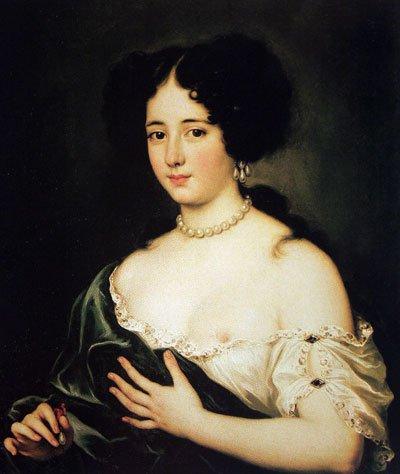
Marie Mancini, Vouet, c1663. Photo: Staatliche Museen, Berlin.
Intelligent and lovely though she may have been, Marie was actually considered to be the least attractive of the sisters, with her uncle in particular commenting on her awkward posture and thinness. In order to sort her out a bit, he consigned both Marie and her younger sister Hortense to the Convent of the Visitation, a popular boarding and finishing school for aristocratic young ladies, where they remained for eighteen months until their uncle decided that they were ready to be introduced to court life again.
Unfortunately, Hieronyma fell ill and died in December 1656 shortly after Marie’s return, still agitating to the very end that her third and to her mind most wayward daughter should be placed in a convent. Luckily for Marie, however, her uncle ignored his sister’s worries, no doubt reasoning that his beautiful, popular nieces were far too useful to him to be shut away behind convent walls for the rest of their lives, especially as they were beginning to catch the eyes of some of the most powerful men at court, including the King himself, who was completely smitten with all of the girls and was even rumoured to have had a brief affair with Marie’s elder sister, Olympe, at some point in 1656 before she made a splendid marriage with Prince Eugène de Savoie-Carignan in February 1657.
It was Marie’s budding romance with the twenty year old King Louis that really caught the attention of the court though. Although the couple had known each other ever since Marie’s first arrival in Paris in 1654, it was not until four years later that their friendship began to turn into something far more serious with the couple being frequently spotted hanging about together in the gardens of Fontainebleau, that favorite romancing spot of the French kings, over the summer of 1658. The general consensus was that they were madly in love and indeed, neither Marie or Louis seemed in any great hurry to hide their feelings for each other as they danced together in the court ballets written for the court by that most magical collaboration of Molière and Lully.
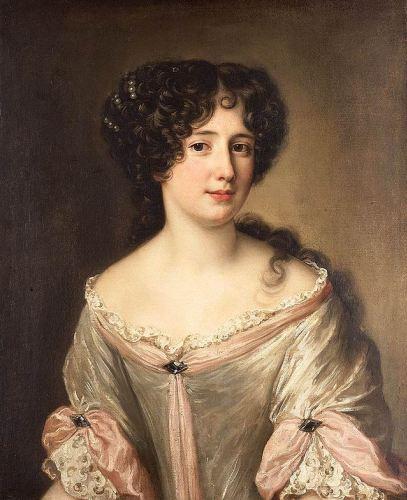
Marie Mancini, Vouet, c1665. Photo: Rijksmuseum, Amsterdam.
Unsuitable though Marie may have been as an actual bride, her romance with the king was not regarded with wholehearted dismay by those close to him, with even his rather difficult to please cousin, La Grande Mademoiselle, who had once sought to marry him herself and who always harboured something of a crush for him, commenting that ‘The King was in a much better humor after he fell in love with Mademoiselle de Mancini. He was lively, he chatted with everyone. I think that she advised him in his readings of novels and poetry.’ Clearly, Marie, with her passion for books and confident personality, was being something of a good influence on her famously rather shy boyfriend and even her uncle and the Queen Mother were pleased by Louis’ new interest in literature and the arts, something that it was felt could only enhance his prestige as monarch and patron. However, they were rather less than keen on all the whisperings and burning looks and long LONG walks through the beautiful moonlit gardens of Fontainebleau that accompanied all the pleasing chatter about books and music and determined to put a stop to it.
Ambitious though he may have been to see his nieces married off into some of the most glitteringly prestigious families in Europe, even Mazarin realised that there was no way on earth that he could ever so much as attempt to marry Marie off to Louis and so he, probably with a private element of reluctance, colluded with Anne of Austria’s plans to promote an altogether more suitable match for the young king, with his first cousin (twice over in fact as both her parents were siblings of his), Maria Theresa of Austria, the daughter of the King of Spain.
The Spanish marriage, which would have united Louis with her niece and created another alliance with her own family and country of Spain, had been close to Anne of Austria’s heart for decades but had been scuppered for many of those years by the ongoing hostilities between France, her adopted country and the land of her birth. Now, however, with a cessation of the war in 1658, her chance had finally come and she threw all her considerable influence behind a Spanish marriage for her son, much to that son’s dismay as with all the idealism of twenty, he had rather set his own heart on a love match with Marie. Awkward.
However, he gloomily agreed to at least consider a foreign princess as his bride and in the autumn of 1658, dragged the court down to Lyon to meet with another prospective fiancée, Princess Marguerite de Savoie, yet another first cousin, this time on his father’s side as her mother, Christine, was a Princess of France. The journey down to Lyon was punctuated with all manner of courtly frivolities and the court’s time in the city itself was a whirl of parties, balls, ballets and banquets – all of which were presided over by Louis and Marie, whom he had insisted should accompany him. In what was like the worst royal blind date ever, the young princess Marguerite was pretty much ignored by her cousin, who preferred instead to devote all of his attention to the much more fascinating Marie.
It was at this point that Mancini and Queen Anne REALLY started to worry as even though Louis was giving every appearance of going along with their plans, there was no real enthusiasm to his acquiescence and he still continued to romance Marie as ardently as ever, the total inseparability of the couple, giving rise to very real concerns that he might actually just marry her instead, especially when his mischievous and outspoken royal visitor, Queen Christina of Sweden loudly encouraged him to defy convention just as she always delighted to do and marry as he pleased for love.
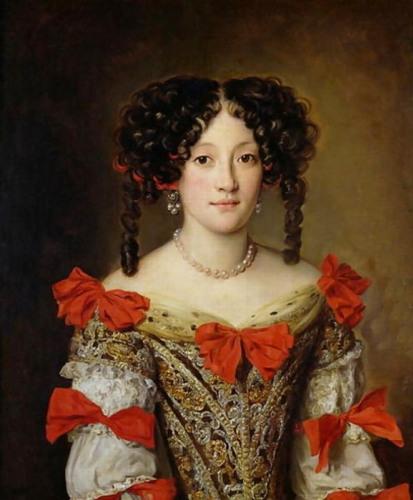
Marie Mancini, Vouet, Musee de la Ville de Paris, Musee du Petit-Palais, France.
Matters finally reached a head in 1659, when Queen Anne’s brother, Philip IV of Spain finally showed some decided inclination towards a match between his daughter, the Infanta Maria Theresa and Louis, a marriage that had probably been more or less inevitable given the end of the war a year earlier and the necessity to formalise the peace with a treaty. It was time for Marie to go.
In June 1659, Louis was informed in no uncertain terms that his affair with Marie was at an end and that she would be leaving Paris. In vain, the young king pleaded with his mother and the implacable Mazarin that he be allowed to keep Marie at his side and even marry her, as Christina of Sweden, who had been very taken with Marie as well, had advised, for love. His pleas fell on deaf ears and the next day, the 22nd of June, Marie, along with her sisters Hortense and Marie Anne left Paris in the escort of her uncle. Louis, predictably, begged to be allowed to say goodbye to his love but was permitted to only make a public farewell before she stepped into her coach.
It must have made for an exceptionally moving scene: the young king sobbing desperately before pressing his final gift, either a necklace or earrings (accounts vary but I lean more towards earrings) of precious pearls, bought in a rush from his impoverished exiled aunt, Henrietta Maria of England, into her hands. According to Marie her final words to the weeping Louis were a dignified: ‘Sire, I am leaving and you weep, and yet you are king’ before she climbed into her coach and was whisked away.
Marie and her sisters parted company with her uncle in Poitiers, with he cruelly going on to finalise arrangements with the Spanish while his nieces went on to La Rochelle for a period of elegant exile. Marie would later recall that: ‘I cannot conceal the pain that this separation caused me; nothing has hurt me so deeply in my life. All possible suffering seemed to me as nothing in comparison to this absence. There was not a moment when I did not wish for death, as the only cure for my ills.‘ Sentiments that are no doubt familiar to any young woman who has been suffered the sudden end of an intense relationship, particularly one in the teenage years when everything seems a million times worse and harder to bear.
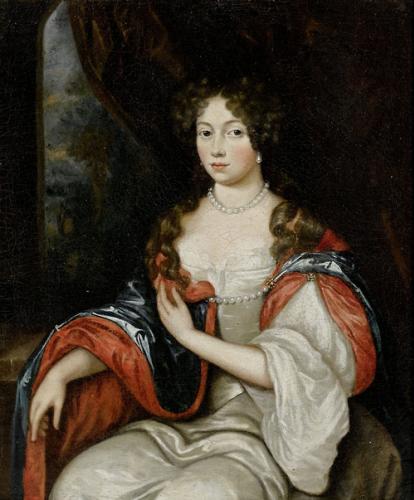
Marie Mancini, Netscher. Photo: unknown location.
To her credit, however, Marie did her best to rally once they had arrived in La Rochelle and no doubt buoyed up by the company of her young sisters she did her best to enjoy her exile by putting on plays and enjoying an exhausting round of parties, fireworks displays and evenings at the theater. There are far worse places to be exiled to than La Rochelle but eventually Marie, who had the family flair for melodrama, began to feel oppressed by her very enjoyment of life and in a surprise move, left the pleasures of the town behind and instead retreated to the château de Brouage, a rather forbidding structure overlooking the sea, where she devoted herself to a period of wholeheartedly throwing herself into the misery of her separation with Louis, which had taken a bittersweet turn thanks to the copious and rather voluminous secret correspondence between the two which had commenced almost as soon as her carriage had rattled out of Paris, with the king even managing to smuggle her a present in the form of a tiny pet dog, who wore a collar inscribed with the words ‘I belong to Marie‘.
I can imagine her standing on the cliff tops of Brouage, sobbing in the rain like a seventeenth century Marianne Dashwood, writing endless desperate letters to her absent love and spending hours brooding over the more depressing of her romantic novels, whose beleaguered heroines, abandoned and dejected, must surely have struck a chord with her own depressed mood. She also spent a great deal of time consulting with a local astrologer, no doubt wondering if perhaps her father had been right all along with his gloomy prognosis that she would bring trouble to the family and would be better off in a convent.
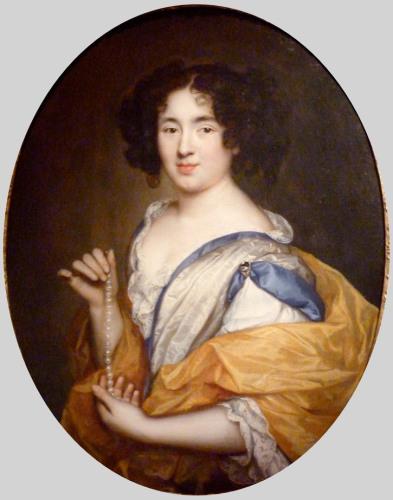
Marie Mancini, c1660, Mignard. Photo: Private Collection.
When the secret correspondence between his niece and the King came to the ears of Mazarin he was, unsurprisingly, completely enraged and immediately turned his attention to putting a stop to it both by increasing measures to intercept letters and also appealing to Louis’ with a heartfelt letter that begged him to reconsider his passion for Marie, which he predicted would cause Louis’ ‘ruin’ and also went so far as to say of his own niece that ‘she has an ambition without bounds, a restless and awkward spirit, a contempt for all the world, no prudence in her conduct, and inclination to all extravagancies.’ Louis remained initially unmoved but then in time began to crumple in the face of the united front presented by his mother and mentor as well as the snowballing negotiations with Spain, which now reached a point of no return and committed him to a match with his cousin Maria Theresa.
In August 1659, the court traveled from Paris to the Spanish border for the final negotiations for the forthcoming marriage and on the way, Louis managed to cajole his mother into giving him permission to visit Marie at Brouages, where they spent long hours together reaffirming their eternal loyalty to each other no matter what. The young king had accepted his fate and was now simply keen to what he saw as the right thing by Marie, reassuring her that although he was marrying someone else, his heart would always belong to her.
Keen to ensure that the break would be a permanent one, Mazarin waited for the king to return to Paris and moved on to a much more cunning scheme, which was to encourage Marie’s elder sister, Olympe, whom Louis had always rather fancied to flirt with him and even seduce him if she was able, with the intention that court gossip about the pair would come to Marie’s ears in far away Brouage. As he had planned, this complete and most appalling humiliation and the official announcement of Louis’ betrothal was enough to break even Marie’s spirit and in response she wrote to her uncle begging him to ‘grant me two requests: the first, to keep people from mocking me, and the second, to save me from their cruel laughter by arranging a marriage for me, quickly.’ Poor Marie.
Marie’s governess, Madame de Venelle reported to Mazarin that her charge was no longer replying to Louis’ letters and that in fact the latter was beginning to write less frequency nowadays. However, she suspected that this might just be another stratagem set up by the young couple, whom she feared had found some other more secret means to communicate, writing that although ‘I think that Mademoiselle’s intentions are good… I fear that fire is smouldering under those ashes, and if the two were to see each other, I doubt that their generosity would last.‘
Nonetheless, Louis was married amidst enormous pomp and celebration to his cousin Maria Theresa of Austria on the 9th of June 1660 at the chapel of Fontarabie near the Spanish border and the next day knelt alongside his new father-in-law to swear eternal peace between their countries, after which he began the long journey back to Paris with his new Queen at his side. At some point in the journey, Louis left his entourage and made the journey with some of his closest friends to Brouage. Marie, however, was not there, as she had traveled back to Paris almost as soon as the King left it for his wedding in Spain. Louis had known of course that he wouldn’t find her in the forbidding fortress by the sea but had apparently been overwhelmed, again with echoes of Marianne Dashwood, to stand once more where they had been last together before he returned to his new married life.
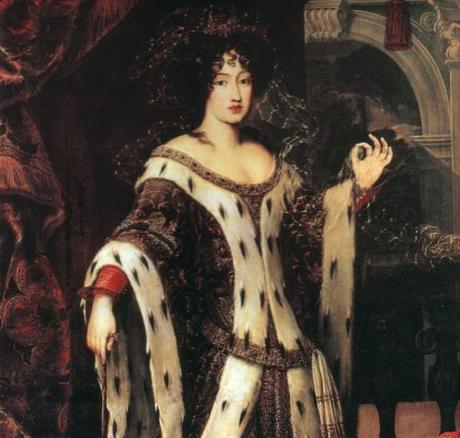
Marie Mancini as Princess of Colonna, unknown artist, c1662. Photo: Palazzo Colonna, Rome.
Meanwhile, efforts to set Marie up with a suitable husband gathered pace as Louis returned to Paris and Mazarin, who knew all about the trip to Brouages, became alarmed that all his carefully played stratagems would have been for nothing. At first it looked likely that his niece would be married to Prince Charles de Lorraine, but as this match would keep Marie at the French court, it was eventually discarded in favour of one with an Italian aristocrat, Lorenzo Onofrio Colonna, who had always had a bit of a thing for Marie and had even proposed to her a few years before only to be summarily rejected as she was then at the height of her romance with Louis and in no mood to consider any other suitors.
If Marie had expected her romance with Louis to rekindle once he returned to Paris, she was quickly disabused of this notion as he made no attempts to seek her out and even behaved with notable iciness towards her when she made her formal obeisance to the new Queen, who also behaved with clear and humilating hostility towards her, that summer. Heartbroken, Marie withdrew from court and even asked her sister, Hortense, who was her closest friend and most trusted confidante to ‘speak ill’ of the King to her in the hopes that this would make her fall out of love with him. Haven’t we all been there? Finally, she gave her consent to the Colonna marriage that would take her out of France completely and the contract was duly signed in February 1661, with the marriage taking place shortly afterwards in April in the Louvre chapel. Her husband, who immediately whisked her away from the heartbreak and dangerous temptations of Paris to a new life and exile in her native Rome, is said to have been shocked to find Marie still a virgin on their wedding night.
******
Set against the infamous Jack the Ripper murders of autumn 1888 and based on the author’s own family history, From Whitechapel is a dark and sumptuous tale of bittersweet love, friendship, loss and redemption and is available NOW from Amazon UK and Amazon US.
‘Frothy, light hearted, gorgeous. The perfect summer read.’ Minette, my young adult novel of 17th century posh doom and intrigue is now 99p from Amazon UK and 99c from Amazon US. CHEAP AS CHIPS as we like to say in dear old Blighty.
Blood Sisters, my novel of posh doom and iniquity during the French Revolution is just a fiver (offer is UK only sorry!) right now! Just use the clicky box on my blog sidebar to order your copy!
Follow me on Instagram.
